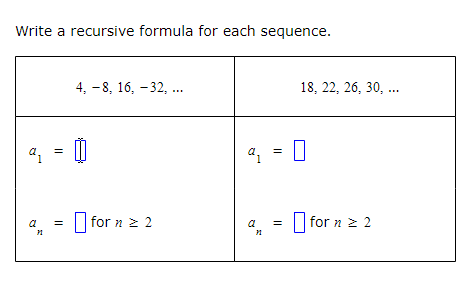

In a geometric sequence, each term is obtained by multiplying the previous term by a specific number. Why? In an arithmetic sequence, each term is obtained by adding a specific number to the previous term. If we go with that definition of a recursive sequence, then both arithmetic sequences and geometric sequences are also recursive. Recursion is the process of starting with an element and performing a specific process to obtain the next term.
#Recursive sequences calculator series
Sequence is defined as, F 0 = 0 and F 1 = 1 and F n = F n-1 + F n-2 Sequence and Series Formulas If the reciprocals of all the elements of the sequence form an arithmetic sequence then the series of numbers is said to be in a harmonic sequence.įibonacci numbers form a sequence of numbers in which each element is obtained by adding two preceding elements and the sequence starts with 0 and 1. Some Common SequencesĪ sequence in which every term is obtained by adding or subtraction a definite number to the preceding number is an arithmetic sequence.Ī sequence in which every term is obtained by multiplying or dividing a definite number with the preceding number is known as a geometric sequence. In case of an infinite series, the number of elements are not finite i.e.

Series: In a finite series, a finite number of terms are written like a 1 + a 2 + a 3 + a 4 + a 5 + a 6 + ……a n. whereas, an infinite sequence is never-ending i.e. Sequences: A finite sequence stops at the end of the list of numbers like a 1, a 2, a 3, a 4, a 5, a 6……a n. However, there has to be a definite relationship between all the terms of the sequence. So, the second term of a sequence might be named a 2, and a 12 would be the twelfth term.Ī series termed as the sum of all the terms in a sequence. The terms of a sequence usually name as a i or a n, with the subscripted letter i or n being the index. The numbers in the list are the terms of the sequence. Sequence and Series FormulaĪ sequence is an ordered list of numbers. Let us start learning Sequence and series formula. The length of a sequence is equal to the number of terms, which can be either finite or infinite. Sequence and series are similar to sets but the difference between them is in a sequence, individual terms can occur repeatedly in various positions. A series is the addition of all the terms of a sequence.

A sequence is an ordered list of numbers.


 0 kommentar(er)
0 kommentar(er)
